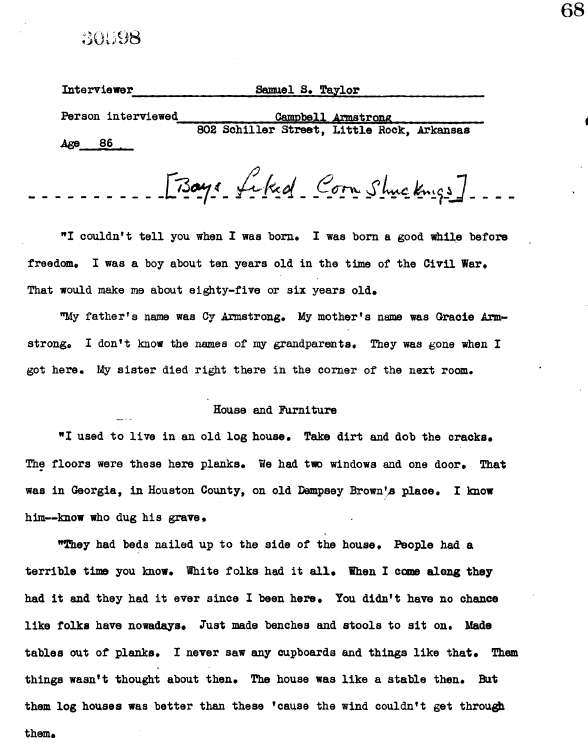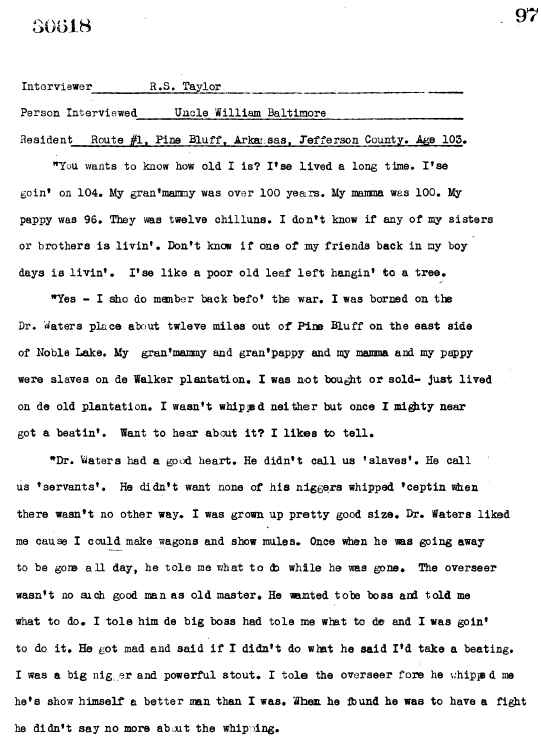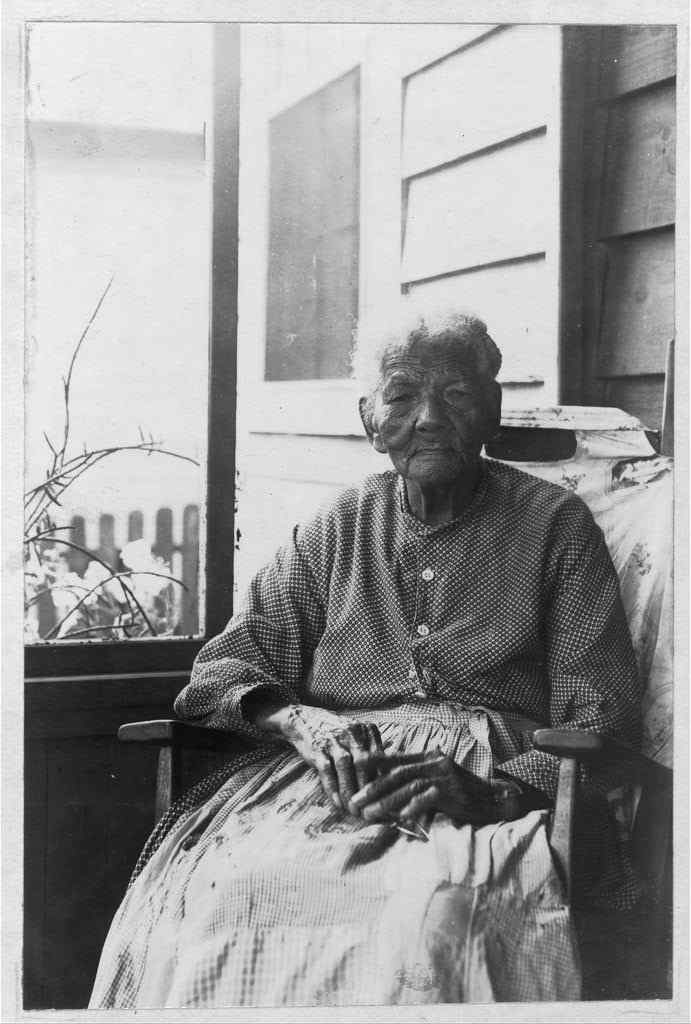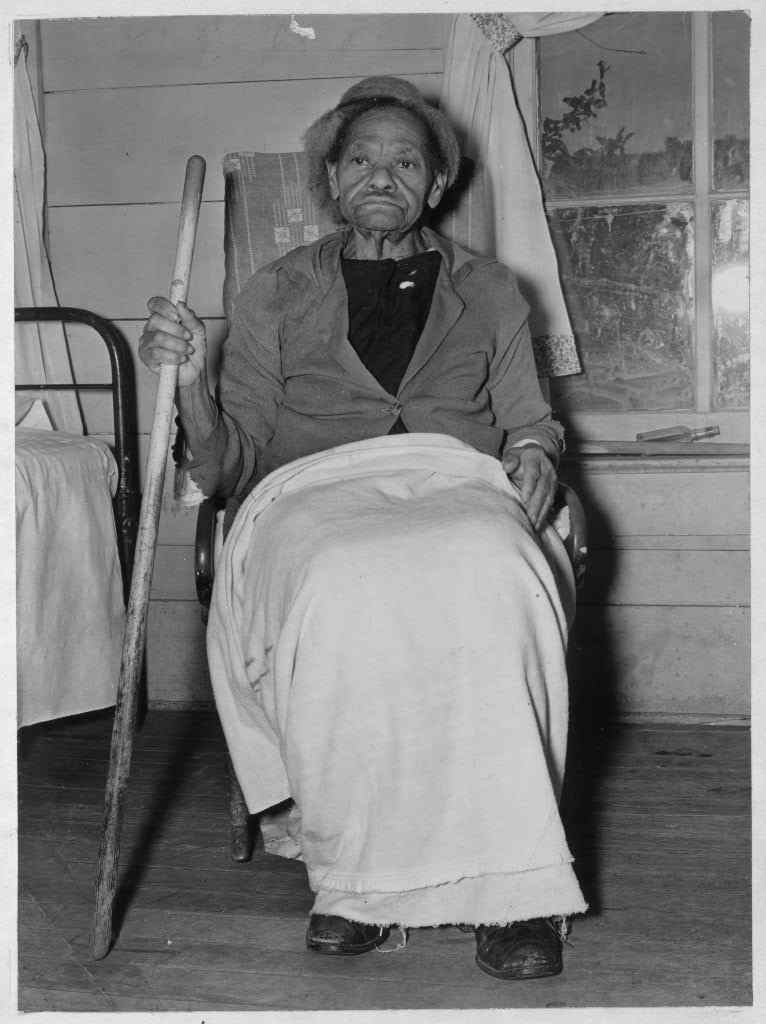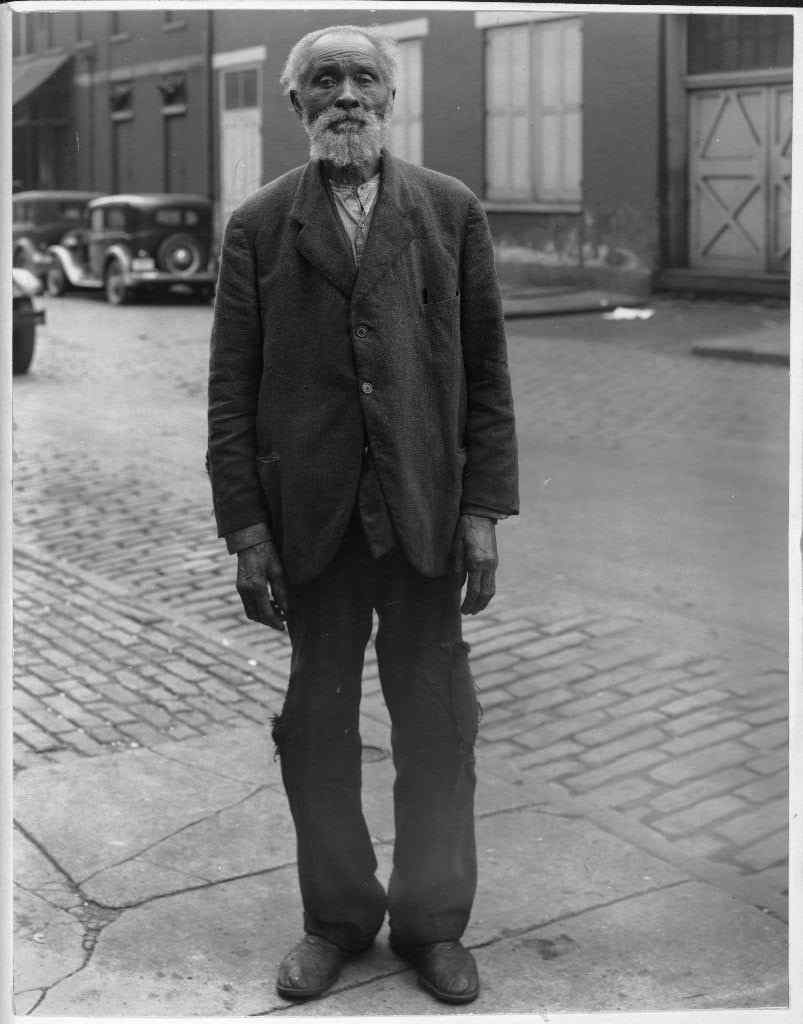|
Slave narratives from the Federal Writers' roject, dating from 1936 to 1938, containing more than 2,300 first-person accounts of slavery in America. These narratives were collected as part of the Federal Writers' Project of the Works Progress Administration (WPA) and assembled and microfilmed in 1941 as the seventeen-volume Slave Narratives: A Folk History of Slavery in the United States from Interviews with Former Slaves.
In the Depression years between 1936 and 1938, the WPA Federal Writers' Project (FWP) sent out-of-work writers in seventeen states to interview ordinary people in order to write down their life stories. Initially, only four states involved in the project (Florida, Georgia, South Carolina, and Virginia) focused on collecting the stories of people who had once been held in slavery. John A. Lomax, the National Advisor on Folklore and Folkways for the FWP was extremely interested in the ex-slave material he received from these states. In 1937 he directed the remaining states involved in the project to carry out interviews with former slaves as well. Federal field workers were given instructions on what kinds of questions to ask their informants and how to capture their dialects . They often visited the people they interviewed twice in order to gather as many recollections as possible. The workers then turned the narratives over to their state's FWP director for editing and eventual transfer to Washington, D.C. The administrative files accompanying the narratives detail the information supplied to field workers as well as subjects of concern to state directors of the FWP.
America's slave narrative collection provides a unique and virtually unsurpassed collective portrait of a historical population. Historian David Brion Davis in his book, "Slavery and the Post-World War II Historians,"
has argued that the voluminous number of documented slave testimonies available in the United States "is indisputably unique among former slaveholding nations." In addition to the substantial number of life histories it contains, the most compelling feature of the collection is the composition of the sample of people who made up its informants. Although not a representative sample of the slave population, they were a remarkably diverse and inclusive cross-section of former slaves. Those whose voices are included in the collection ranged in age from one to fifty at the time of emancipation in 1865, which meant that more than two-thirds were over eighty when they were interviewed. Almost all had experienced slavery within the states of the Confederacy and still lived there. They represented all the major slave occupations. Moreover, the size of the slave units on which respondents reported living varied considerably, from plantations with over a thousand slaves to situations in which the informant was his or her owner's only slave. The treatment these individuals reported ran the gamut from the most harsh, impersonal, and exploitative to work and living conditions and environments that were intimate and benevolent. In fact, except that most of the informants were relatively young when they experienced slavery (older slaves had died long before these interviews were undertaken), all the major categories of the slave population appear to be well represented in the collection.
Included among the many topics: slave masters, overseers, treatment of slaves, whippings, marriages, skin color, child birth, child rearing, diet, health, medicine, church going, social customs, folklore, religion, superstition, education, runaway slaves, patrollers, jayhawkers, male slave owners relations with female slaves, blacks in the Confederate army, slave quarters, parents, family separations, Civil War, Confederate Army, Union soldiers entering the South, Ku Klux Klan, and the transition from slavery to freedom.
The lives sampled include:
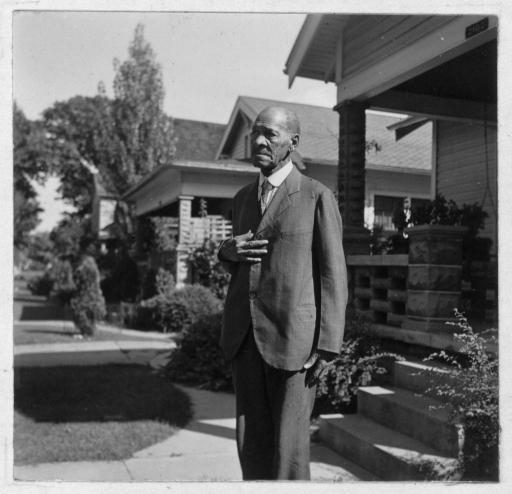
John W. Fields, Age 89
"In most of us colored folks was the great desire to [be] able to read and write. We took advantage of every opportunity to educate ourselves. The greater part of the plantation owners were very harsh if we were caught trying to learn or write. It was the law that if a white man was caught trying to educate a negro slave, he was liable to prosecution entailing a fine of fifty dollars and a jail sentence. We were never allowed to go to town and it was not until after I ran away that I knew that they sold anything but slaves, tobacco, and whiskey. Our ignorance was the greatest hold the South had on us. We knew we could run away, but what then? An offender guilty of this crime was subjected to very harsh punishment."
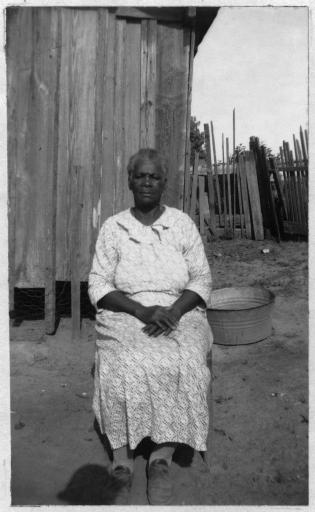
Tempie Cummins, Age Unknown
"The white chillun tries teach me to read and write but I didn' larn much, 'cause I allus workin'. Mother was workin' in the house, and she cooked too. She say she used to hide in the chimney corner and listen to what the white folks say. When freedom was 'clared, marster wouldn' tell 'em, but mother she hear him tellin' mistus that the slaves was free but they didn' know it and he's not gwineter tell 'em till he makes another crop or two. When mother hear that she say she slip out the chimney corner and crack her heels together four times and shouts, 'I's free, I's free.' Then she runs to the field, 'gainst marster's will and tol' all the other slaves and they quit work. Then she run away and in the night she slip into a big ravine near the house and have them bring me to her. Marster, he come out with his gun and shot at mother but she run down the ravine and gits away with me."
Among the many interviewed include:
Charity Anderson, 101 years old, lived near Mobile, Alabama at the time she was interviewed. She was born at Belle's Landing, in Monroe County, Alabama. Her master operated a wood yard that supplied fuel to river boats. Anderson was a house slave. She recalls that her master treated all his slaves well, but she also remembered seeing slaves torn up by dogs and whipped unmercifully.
Mary Reynolds, blind and over one hundred years old at the time of her interview, was born into slavery in Black River, Louisiana. Her master, a physician and planter, was a shrewd speculator who frequently traded his older slaves for younger, more fit hands. Reynolds witnessed brutal beatings, and tells of working in weather so cold that her hands bled. Her master had a number of children with a mulatto slave, and his wife threatened to leave him. After the war, Mary Reynolds moved to Texas, where she remained for the rest of her life.
Clayton Holbert, 86 years old, was born and raised in Linn County, Tennessee. His master, Pleasant Holbert, owned about 100 slaves, who raised corn, barley, and cotton. The plantation was self-sufficient; slaves on Holbert's farm wove their own clothes, butchered their own meat, and made their own maple sugar. Clayton Holbert's mother and grandmother were both deeded their freedom, but were captured by slave dealers and sold back into slavery. Holbert's father, brother, and uncle joined the Union Army during the Civil War.
Walter Calloway was born in Richmond, Virginia, in 1848. Calloway and his mother and brother were purchased by John Calloway, who owned a plantation ten miles south of Montgomery, Alabama. By the time he was ten years old, Walter Calloway was doing a grown man's work. The white overseer used a black hand to administer the whippings; Calloway recalls seeing one thirteen-year-old girl whipped almost to death. Calloway also tells of worshipping in a brush arbor, the outbreak of the Civil War, and federal troops ransacking the plantation at war's end.
Emma Crockett, about 79 or 80 years old, She was the daughter of Cassie Hawkins and Alfred Jolly, and the slave of Bill and Betty Hawkins. After emancipation, she learned to read a bit of printing, but never learned how to read handwriting. She was a member of the New Prophet Church; despite her headache the day she was interviewed, she sang her favorite hymn for the interviewer.
Lucinda Davis, of Tulsa, Oklahoma, did not know where she was born, but she did manage to reunite with her parents after the end of the Civil War. She was the slave of a Creek Indian named Tuskaya-hiniha and his white wife, Nancy Lott. She was one of about ten slaves on a farm near Honey Springs, about twenty-five miles south of Fort Gibson. Creek was spoken in their home, and Davis recalls Creek funerals, dances, and recipes. In the confusion of the Civil War, one slave after another left her master until only she, too young to leave on her own, remained.
Tempe Herndon Durham, 103 years old, grew up on a large plantation in Chatham County, North Carolina, west of Raleigh. The plantation where she lived, owned by George and Betsy Herndon, raised corn, wheat, cotton, and tobacco. Durham describes in detail how female slaves spun, wove, and dyed cloth on the plantation. She married Exter Durham on the front porch of her master's home; her master threw a big party for their wedding, but the following day Exter had to return to his own master's plantation. After the war, the couple settled on Herndon's place, where they rented until they saved enough money to buy their own farm.
Joseph Holmes, 81 years old, was born in Henry County, Virginia, near Danville. He was the son of Eliza Rowlets and Joseph Holmes. He left Virginia for Georgia, and eventually made his way to Mobile, Alabama, where he lived at the time of his interview. He recalled that his mistress did not allow her slaves to be mistreated, because she was raising slaves for the market, and she considered it poor business to mistreat them. Holmes told his interviewer that it took ten or twelve years before he fully understood what his mistress meant when she told him he was free.
Ben Horry, 89 years old, lived at Murrells Inlet, on the South Carolina coast about ten miles south of Myrtle Beach. In the characteristic patois of the low country, Horry described his work as a boatman, the federal occupation during the Civil War, the punishment his father received for intemperate drinking, and the diet of the low country.
Richard Toler was born near Lynchburg in Campbell County, Virginia. He was the son of George Washington Toler and Lucy Toler, and the slave of Henry Toler. As a youngster, Richard Toler tended to the cows and calves on his master's 500-acre farm; later, he hoed in the fields. He learned blacksmithing as a slave, and after emancipation he earned his living as a smith for 36 years. After the Civil War he bought a fiddle, and became an accomplished musician, playing for white dances and at hoe downs. He recalls medical treatment under slavery, as well as details of diet and clothing. He also recalls the brutal whipping of young girls by his master's sons.
The disc contains a text transcript of all recognizable text embedded into the graphic image of each page of each document, creating a searchable finding aid.
Text searches can be done across all files in the collection
|
